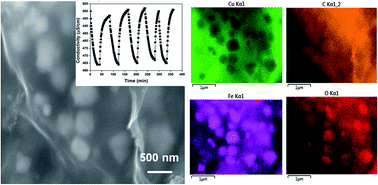Hydrothermally synthesized graphene and Fe3O4 nanocomposites for high performance capacitive deionization
Abstract
Capacitive deionization (CDI) devices with low energy consumption and high salt removal efficiencies have attracted much attention. Recently, graphene has been proved to be one of the most promising materials for CDI electrodes. However, pristine graphene is far from desirable due to its low removal efficiency and unavoidable decays in performance. In this study, a reduced graphene oxide/Fe3O4 nanoparticle (RGO@Fe3O4) hybrid is proposed and synthesized via a hydrothermal approach for enhanced CDI. Electrochemical analysis of this nanocomposite material has revealed typical electrical double layer capacitive behaviour and an improved specific capacitance. Furthermore, the electrosorption capacity and current efficiency of RGO@Fe3O4 were found to be nearly two folds higher than that of RGO. This huge improvement is attributed to the hydroxylation of the Fe3O4 surface. In addition, the maximum electrosorption capacity predicted from the Langmuir isotherm was ∼8.33 and ∼4.63 mg g−1, corresponding to the RGO@Fe3O4 and RGO electrode, respectively.


 Please wait while we load your content...
Please wait while we load your content...